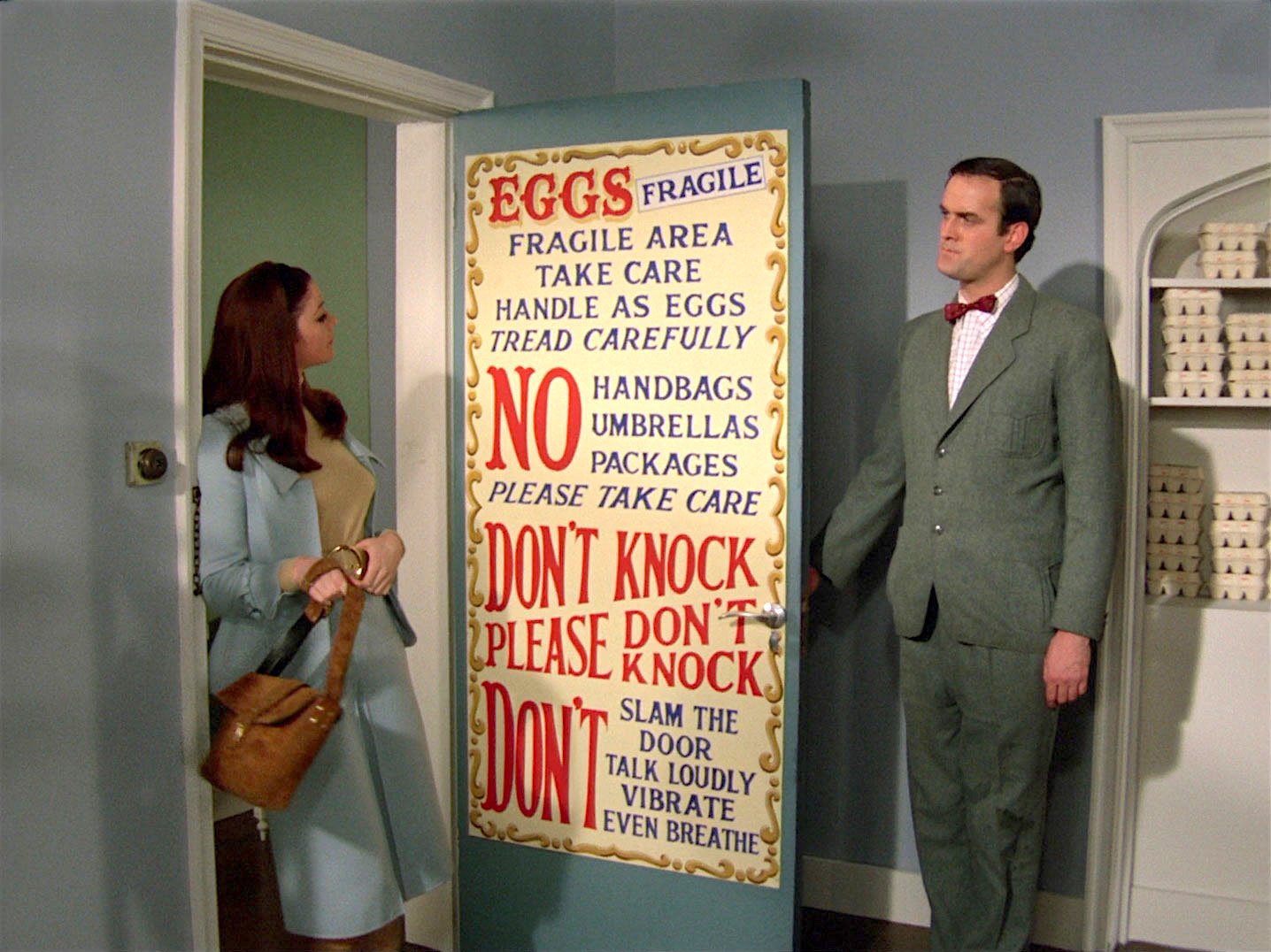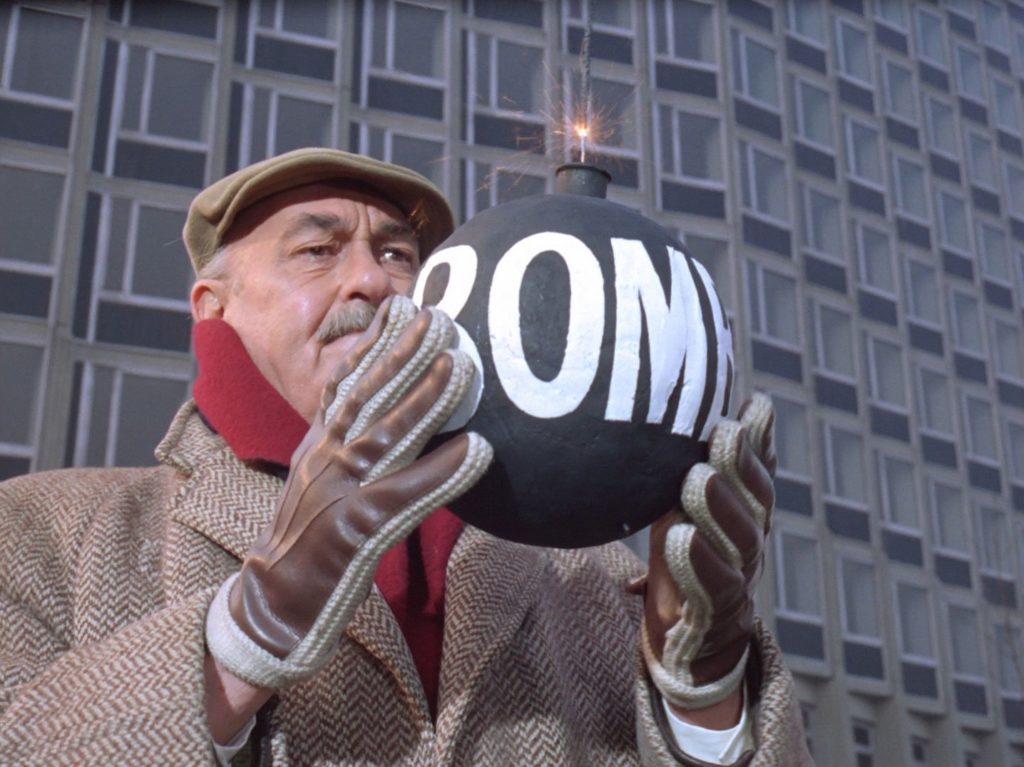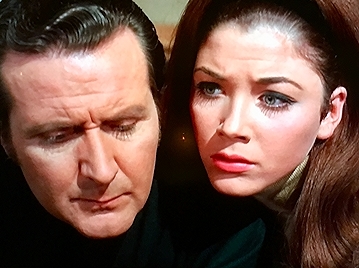Look – (Stop Me If You’ve Heard This One) but There Were These Two Fellers… that’s the full title to an episode determined that, since the day of The Avengers are numbered, things might as well go out with a bang.
It’s written by the insanely prolific Dennis Spooner, whose name came to dominate British TV as the 1960s gave way to the 1970s and was dead at the ridiculously young age of 53 in 1986. Perhaps it was overwork.
Musings on mortality to one side, this is a great episode for all sorts of reasons. Top of those is the cast, which is full of British comedians from all sorts of different traditions. Pride of place goes to old stager Jimmy Jewel, who plays one of a pair of clowns killing people theatrically – with a gun that goes bang, or with a bomb with “BOMB” emblazoned on it and a big fizzing fuse sticking out the top being just two examples.
The first of the deaths happens pre-credits, with Sir Jeremy Broadfoot (Richard Young) copping it when Maxie Martin (Jewel) and mute sidekick Jennings (Julian Chagrin) arrive at Broadfoot’s office to do the deed, but not before they’ve first performed a little vaudeville dance routine.
Sir Jeremy is responsible for the building of the Cupid project, an underground government bunker designed to withstand the impending nuclear holocaust. And after a fellow director of the company, Cleghorn (Bill Shine), has also been despatched in jocular fashion by Maxie and Jennings, the race is on for Steed and King to find out who’s behind the murders.
The clue. In classic Avengers episodes there’s always a clue. Here, it comes from a very long footprint left at one crime scene and a red nose at another. What can it all mean?
No chin-scratching required, Tara King is soon interviewing the man who co-ordinates the registration of a clown’s copyrighted looks – each face is painted onto a blown hen’s egg (this is indeed how it is, or was, done).
Playing the eccentric and comedically timid Marcus Rugman is John Cleese, his character a prototype of many a fawning Monty Python creation. No sign of Basil Fawlty belligerence.
While King is exploring avenue A, Steed is up avenue B, with professional joke writer Bradley Marler (Bernard Cribbins), whose office is full of discarded material, drifts of paper all over the floor. And if the discarded stuff is anything like the weak efforts Marler tries on the distinctly untickled Steed… Dennis Spooner started out as a joke writer, so he knows whereof he speaks.
While this has been going on, two developments. It seems that Maxie and Jennings are being debriefed after every kill by a pair Punch and Judy puppets (worked, uncredited, by Punch and Judy legend “Professor” John Styles). And we learn that the board of the building company whose members keep dying does contain one member who is a good 20 years younger than the rest, and he’s played by the reliably sinister John Woodvine (who, even when he played a good cop back then, was always a tough one).
Vaudeville (pronounced “voh-deville” by Steed and “vor-deville” by Cribbins) provides the background and, given that theatrical exaggeration was an Avengers go-to style, you’ve got to wonder why the show hasn’t been there before.
Jewel, a vaudeville/music hall old hand who was about to have a late-career renaissance on TV (this being part of it) is a combination of Dan Leno and Little Tich, stage legends of the late-Victorian era, whereas the character of sidekick Chagrin is clearly modelled on Harpo Marx, right down to the honking horn (digressive factoid: Chagrin was also the pyjama-clad “secret lemonade drinker” of the R White’s TV advertising campaign in the 1970s).
As the episode progresses we meet more vaudeville refugees and the motive behind the murders begins to reveal itself.
Tara’s hair: it’s long, it’s short. What’s going on? No idea, though the suspicion is that there’s been a bit of reshooting and editing once the Clemens/Fennell production team resumed control, and the changing hair is evidence of that.
The vampy incidental music on the harpsichord and the return to bold primary colours in the set design also indicate a return to business as usual.
“Going right over the top,” is how Spooner described this final season of The Avengers. On the evidence of the pantomime horse that turns up for the big finale, he was probably thinking about this episode.
The Avengers – Watch it/buy it at Amazon
I am an Amazon affiliate. Clicking on the link earns me a (vanishingly small) commission
***
The imdb refers to this as season seven. I’m saying six, along with most of the fan sites and Wikipedia, and in line with the pretty much definitive Studio Canal box set. The reason why the imdb and others say seven is because they’re taking the final block of eight Emma Peel episodes as a separate season. But since there were only eight episodes in that production block, lumping them together with the 16 episodes of what everyone agrees is season five brings the total up to 24, much closer to the usual Avengers run of about 26 episodes.
© Steve Morrissey 2020


